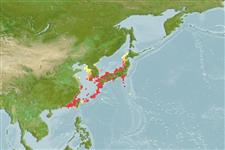>
Gobiiformes (Gobies) >
Gobiidae (Gobies) > Gobionellinae
Etymology: Rhinogobius: Greek, rhinos = nose + Latin, gobius = gudgeon (Ref. 45335).
Issue
This species is synonym of Rhinogobius similis Gill, 1859 according to Suzuki et al., 2015 (Ref. 104791). The species page will be removed.
Environment: milieu / climate zone / depth range / distribution range
Ecologia
marinhas; Água doce; estuarina demersal; anfídromo (Ref. 51243). Subtropical; 45°N - 22°N
Asia: China, Korean Peninsula, Taiwan, and Japan (Ref. 559) and Viet Nam (Ref. 44416).
Comprimento de primeira maturação / Tamanho / Peso / Idade
Maturity: Lm 4.7 range ? - ? cm
Max length : 12.1 cm TL macho/indeterminado; (Ref. 114983); common length : 7.5 cm SL macho/indeterminado; (Ref. 35840); peso máx. publicado: 14.90 g (Ref. 114983)
Descrição suscinta
Chaves de identificação | Morfologia | Morfometria
Espinhos dorsais (total) : 7; Raios dorsais (total) : 8; Espinhos anais: 1; Raios anais : 8.
Found both upstream and in estuaries. Carnivorous. Spawning season from July to October. Eggs are laid under stones in river shoals. Larvae travel in both river and the sea, and return to rivers from September to November. Caught by small trap nets in rivers, but not in abundance.
Ciclo de vida ou comportamento de acasalamento
Maturities | Reprodução | Spawnings | Egg(s) | Fecundities | Larvas
Masuda, H., K. Amaoka, C. Araga, T. Uyeno and T. Yoshino, 1984. The fishes of the Japanese Archipelago. Vol. 1. Tokai University Press, Tokyo, Japan. 437 p. (text). (Ref. 559)
Status na Lista Vermelha da UICN (Ref. 130435)
Ameaça para os humanos
Harmless
Uso pelos humanos
Pescarias: pesca de subsistência
Ferramentas
Relatórios especiais
Baixar XML
Fontes da internet
Estimates based on models
Preferred temperature (Ref.
123201): 17.2 - 26, mean 22.4 °C (based on 245 cells).
Índice de diversidade filogenética (Ref.
82804): PD
50 = 0.5000 [Uniqueness, from 0.5 = low to 2.0 = high].
Bayesian length-weight: a=0.00933 (0.00739 - 0.01179), b=3.08 (3.01 - 3.15), in cm total length, based on LWR estimates for this species (Ref.
93245).
Nível Trófico (Ref.
69278): 3.2 ±0.43 se; based on food items.
Generation time: 1.1 ( na - na) years. Estimated as median ln(3)/K based on 1
growth studies.
Resiliência (Ref.
120179): Elevada, tempo mínimo de duplicação da população menor que 15 meses (Preliminary K or Fecundity.).
Fishing Vulnerability (Ref.
59153): Low vulnerability (14 of 100).
